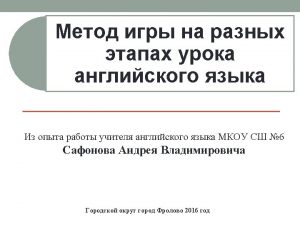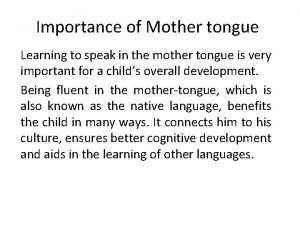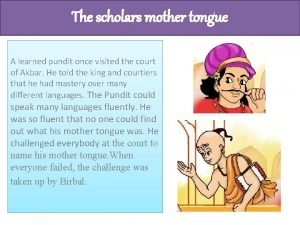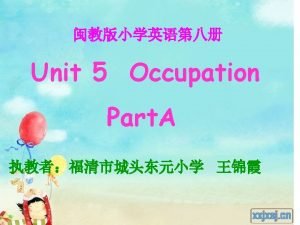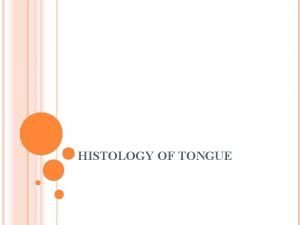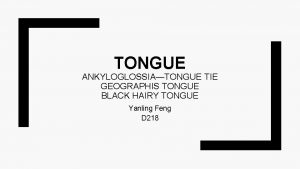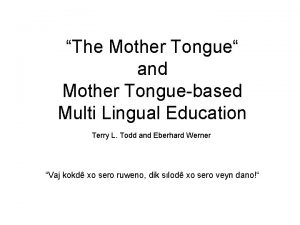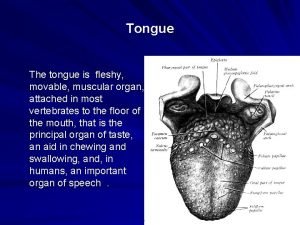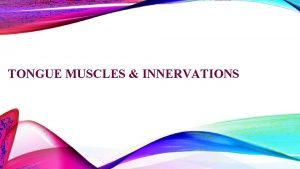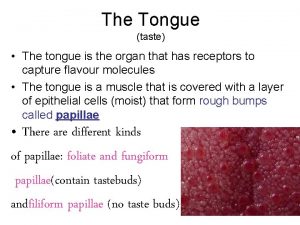CURRENT POLICIES DEVELOPMENTS AND CHALLENGES IN MOTHER TONGUE















- Slides: 15

CURRENT POLICIES, DEVELOPMENTS AND CHALLENGES IN MOTHER TONGUE EDUCATION AMONGST PUBLIC SCHOOLS IN MALAYSIA Presented By Ramanathan Nagarathinam (Assistant Director) Head Of Tamil Language Unit Curriculum Development Centre Ministry Of Education Malaysia

Population of Malaysia Malays Chinese Indians 50. 8% 23. 3% 6. 9% Indigenous Others Non-Citizens 11. 1% 1. 5% 6. 9%

Number of Spoken Languages Peninsular Malaysia Sabah Sarawak 40 54 47 Widely Spoken Languages Malays English Chinese Tamil Kadazandusun Iban

Constitutional Provisions Article 152 of the Malaysian Federal Constitution states that the official-national language is the Malay language. However, the Constitution guarantees the freedom of learning and using of other languages, except for official purposes Education Act 1996 guarantees that: (i) The Chinese or Tamil language shall be made available if the parents of at least fifteen pupils in the school so request; (ii) indigenous languages shall be made available if it is reasonable and practical to do so and if the parents of at least fifteen pupils in the school so request;

Influence of Policies and Ideology in Education System Education Ordinance Education Act Rukunegara (National Ideology) 1957 1961 1996 1969 National Philosphy of Education 1990 Type of Primary School Medium Of Instruction National Primary School Chinese National-type Primary School Tamil National-type Primary School Malay Chinese Tamil

Secondary Education Pupils from the three types of primary schools merge at the secondary level for another five years of uninterrupted compulsory schooling. At this level, the medium of instruction in all schools is the Malay language. Those students from the Chinese national-type and Tamil national-type schools who have not acquired the basic proficiency in Malay are given an opportunity to go through a year of proficiency exposure in Malay before they join the others in the secondary schools.

Introduction of Ethnic Languages Language Iban Kadazandusun Semai Year 1987 1995 1997 Number of Primary Schools Offering Minority Languages in 2007 Language Iban Kadazandusun Semai Number of Schools 282 369 30

Number of Primary Schools in Malaysia as of 2006 Types of Schools No. of Schools National Primary Schools 5774 Chinese National-Type Primary Schools 1288 Tamil National-Type Primary Schools 523 Special Schools (Disabled Students) 28 Total Orthography 7616 Malay, Kadazandusun, Iban and Semai orthographies use the Roman script ( the same script as English) while Chinese and Tamil have their own unique orthographies.

Teaching and Reading Materials • Teaching and learning materials for mother tongue languages are prepared by the Ministry of Education. • The Text Book Division has been devising policies and guidelines, as well as encouraging writers to produce high quality text books and teacher’s guides. • Text books are provided free of charge to teachers and students. • The Curriculum Development Centre and The Education Technology Division under The Ministry of Education produce teaching modules and supportive materials.

Teacher Training • Training for Malay, Chinese and Tamil teachers is based on tests and interviews. • Qualification for Teacher Training College lecturers is being upgraded to Masters and Ph. D levels. • Selection of teachers for mother tongue languages such as Kadazandusun, Iban and Semai is done by choosing candidates who have acquired minimum level of proficiency in the respective languages.

Current Changes • Pilot Project for Chinese and Tamil Languages in National Schools. • English as a Medium of Instruction for the Teaching of Maths and Science in Primary Schools. • Concern about National Unity and Nation. Building. • Common Syllabus and Content.

Action by Malaysian Government • Malaysian government has been willing and open when it comes to discussing issues of mother tongue teaching and learning. • The government is in constant dialogue with leaders of the various ethnic groups to arrive at the most amicable formula in addressing the needs of the nation while taking into interest, the feelings and requests of the various ethnic groups.

• The creation of Malay, Chinese and Tamil medium primary schools is an effort to introduce language literacy. • Efforts of the government have brought about effective changes in transforming these schools into knowledge based institutions • Malay as the national language has played a leading and effective role in transforming a rural agrarian community into a dynamic, industrial and commercial urban community

CONCLUSION • The Malaysian government cannot afford to look into the possibility of introducing the teaching and learning of all ethnic languages because at the moment, the main concern is unity and nation building. • As the country evolves in becoming a developed nation, possibilities and opportunities to make available the teaching and learning of these ethnic languages may become a reality.

THANK YOU TERIMA KASIH
 Poem on mother teresa
Poem on mother teresa Tongue twister ppt
Tongue twister ppt Line current and phase current
Line current and phase current Power formula three phase
Power formula three phase N=nc exp(-eg/2kt)
N=nc exp(-eg/2kt) Line current and phase current
Line current and phase current Drift current and diffusion current in semiconductor
Drift current and diffusion current in semiconductor Drift current and diffusion current
Drift current and diffusion current Balanced wye wye connection
Balanced wye wye connection Infineon
Infineon Diffusion current formula
Diffusion current formula Mary mac's mother tongue twister
Mary mac's mother tongue twister Importance of mother tongue essay
Importance of mother tongue essay Who take the challenge to find pundit mother tongue
Who take the challenge to find pundit mother tongue Mother tongue amy tan questions
Mother tongue amy tan questions Occupation of grandmother
Occupation of grandmother











